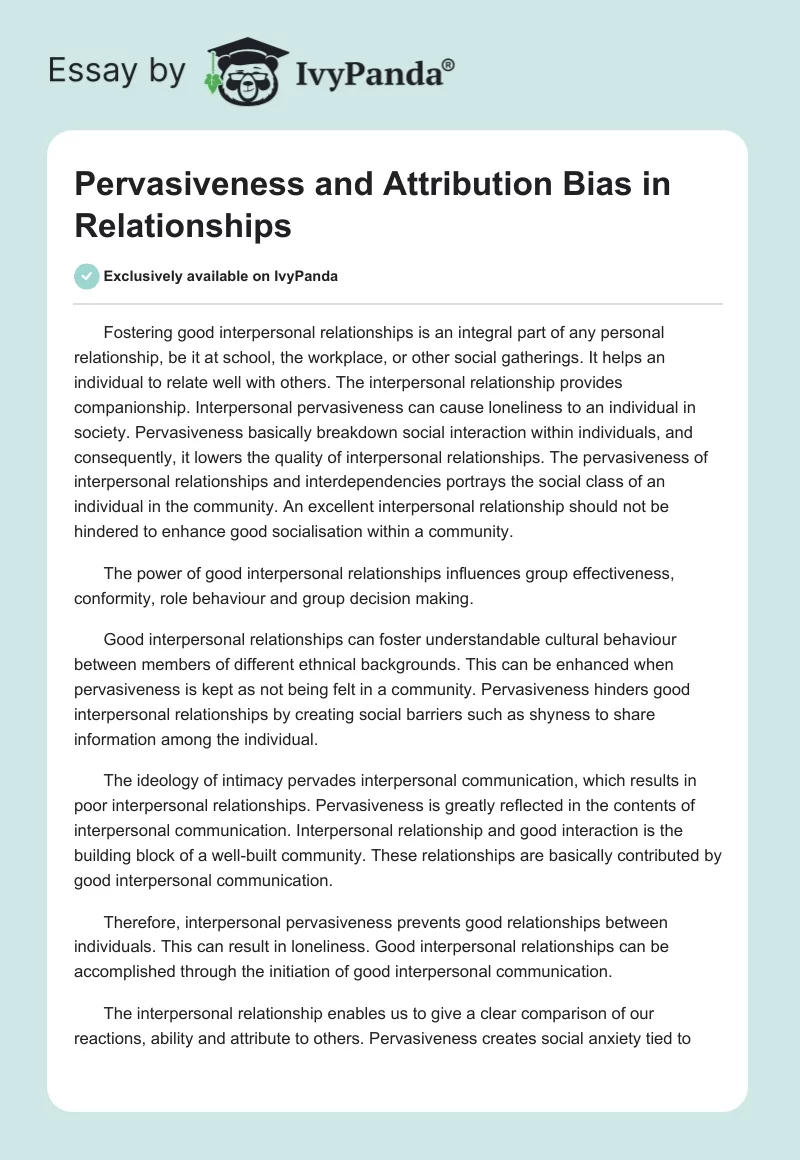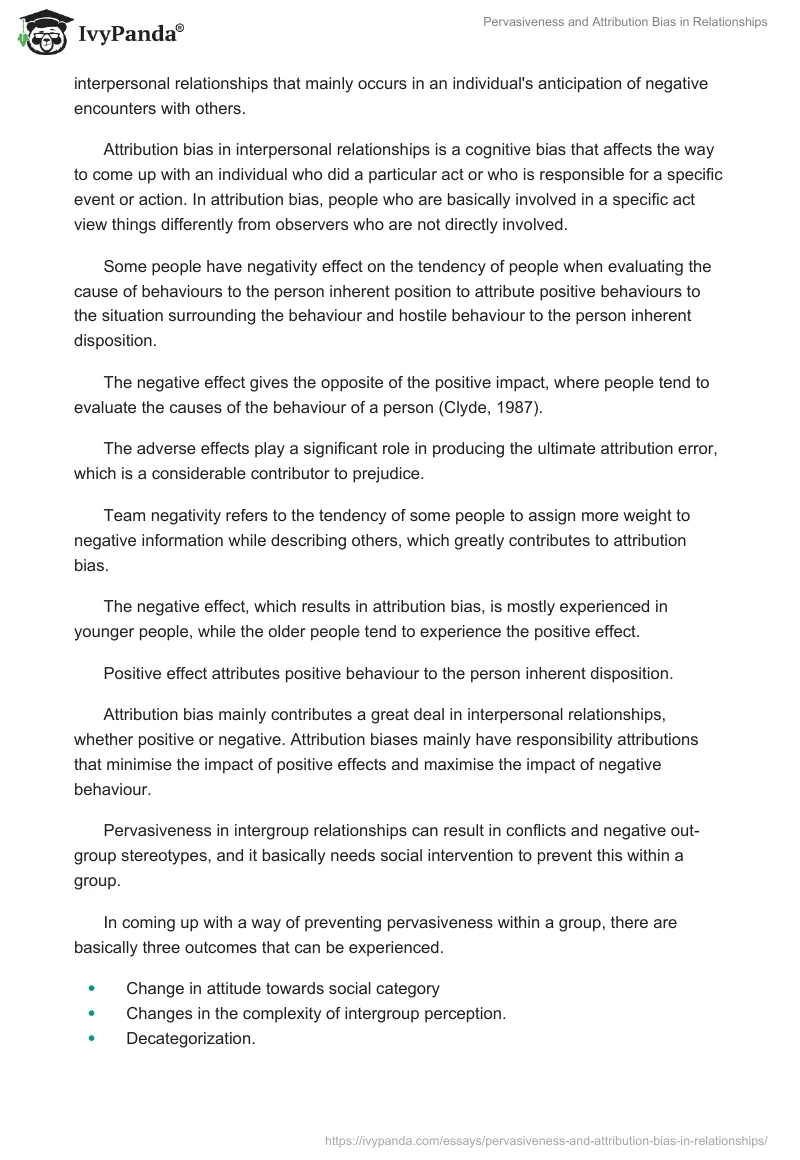Fostering good interpersonal relationships is an integral part of any personal relationship, be it at school, the workplace, or other social gatherings. It helps an individual to relate well with others. The interpersonal relationship provides companionship. Interpersonal pervasiveness can cause loneliness to an individual in society. Pervasiveness basically breakdown social interaction within individuals, and consequently, it lowers the quality of interpersonal relationships. The pervasiveness of interpersonal relationships and interdependencies portrays the social class of an individual in the community. An excellent interpersonal relationship should not be hindered to enhance good socialisation within a community.
The power of good interpersonal relationships influences group effectiveness, conformity, role behaviour and group decision making.
Good interpersonal relationships can foster understandable cultural behaviour between members of different ethnical backgrounds. This can be enhanced when pervasiveness is kept as not being felt in a community. Pervasiveness hinders good interpersonal relationships by creating social barriers such as shyness to share information among the individual.
The ideology of intimacy pervades interpersonal communication, which results in poor interpersonal relationships. Pervasiveness is greatly reflected in the contents of interpersonal communication. Interpersonal relationship and good interaction is the building block of a well-built community. These relationships are basically contributed by good interpersonal communication.
Therefore, interpersonal pervasiveness prevents good relationships between individuals. This can result in loneliness. Good interpersonal relationships can be accomplished through the initiation of good interpersonal communication.
The interpersonal relationship enables us to give a clear comparison of our reactions, ability and attribute to others. Pervasiveness creates social anxiety tied to interpersonal relationships that mainly occurs in an individual’s anticipation of negative encounters with others.
Attribution bias in interpersonal relationships is a cognitive bias that affects the way to come up with an individual who did a particular act or who is responsible for a specific event or action. In attribution bias, people who are basically involved in a specific act view things differently from observers who are not directly involved.
Some people have negativity effect on the tendency of people when evaluating the cause of behaviours to the person inherent position to attribute positive behaviours to the situation surrounding the behaviour and hostile behaviour to the person inherent disposition.
The negative effect gives the opposite of the positive impact, where people tend to evaluate the causes of the behaviour of a person (Clyde, 1987).
The adverse effects play a significant role in producing the ultimate attribution error, which is a considerable contributor to prejudice.
Team negativity refers to the tendency of some people to assign more weight to negative information while describing others, which greatly contributes to attribution bias.
The negative effect, which results in attribution bias, is mostly experienced in younger people, while the older people tend to experience the positive effect.
Positive effect attributes positive behaviour to the person inherent disposition.
Attribution bias mainly contributes a great deal in interpersonal relationships, whether positive or negative. Attribution biases mainly have responsibility attributions that minimise the impact of positive effects and maximise the impact of negative behaviour.
Pervasiveness in intergroup relationships can result in conflicts and negative out-group stereotypes, and it basically needs social intervention to prevent this within a group.
In coming up with a way of preventing pervasiveness within a group, there are basically three outcomes that can be experienced.
- Change in attitude towards social category
- Changes in the complexity of intergroup perception.
- Decategorization.
Intergroup outcome can definitely change general attitude towards an out-group but when it provide distinctiveness if risks are increasing inter group anxiety.
The crossed categorisation can be used to reduce biasness against a group, which experiences differences in multiple dimensions but cannot eliminate bias.
Pervasiveness in intergroup relationships portrays negativity in a situation of conflict.
Pervasiveness basically gives the range of psychological elements and some social processes that can be organised in the structure of conflict. It also portrays the structural change that occurs within society as a result of a conflict (Kenneth, Irwin, 2001).
Conflicts affect society and the social structure of conflicted society. They affect so many things in society, such as norms, values and many other institutions that take place in governing the lives of citizens.
Pervasiveness basically spread negativity and positivity into a previously dependent state of activity within a given group.
Therefore, pervasiveness in any group should be discouraged because it can initiate conflicts and other norms in society, which prevents proper growth within the society.
Attribution bias in a group draws generalisation of individual behaviour. These individual behaviours mainly occur as a result of group influence, demographic diversity and categorisation theory.
Groups mainly share views when they are brought together by the norms. These norms promote and protect inter group bias since they share their views guided by the same principles. Group bias is more likely to be shared in ethnic and in various occupational groups, which are facilitated by their high levels of norms is identification among the members.
Group composition may play an intervening role between an individual of a given ethnic background and group attribution bias. The oneness of team members can greatly contribute to high group influence, which is relevant to members sharing different views. Team homogeneity can portray the likelihood of members displaying attribution bias.
Another element that can contribute to intergroup bias is the race and gender of the members.
Therefore, members’ homogeneity, race and gender are the main contributing factors towards attribution bias in inter group relationships.
Attribution bias mainly relates to two aspects of groups. Bias come in when a person views the action of one or more members of another social group and attributes those views to the characteristic of that group. In-group means that this individual is contributing while out-group, an individual is observing.
Intergroup bias can be explained by social identity theory, which states that individual members of the group need to maintain their self0esteem by being associated with a group with some aspect in them. These individuals tend to view their groups a lot positively to make them feel better.
One of the factors that contribute to inter-group bias is the attribution process. The positive action in the in-group is attributed to disposition factors that are discounted since they contribute to situational factors.
Another type of inter-group bias is a stereotype. In-group members have ways of identifying the out group members. The stereotypes they use are part of the attribution bias process. For example, a white man can view a woman of Asian descent who does well in exams. The man might view the woman’s performance to be based on his stereotype. And in case the woman is white, the man may view her performance as a result of hard work.
Inter group bias can be observed from a different perspective in various cultures. These perspectives include:
- Political spectrum –This produces intergroup with different viewpoints.
- Academic spectrum.
- Urban spectrum.
Therefore, attributional bias is the tendency of individuals to interpret the intent of others which creates negative feelings for individual intergroup attribution bias can give very strong evidence on bias while revealing its association with both effect and self-esteem.
Moreover, attribution biases can be contributed greatly by ethnic, Nationalist and other inter-group violence. Mainly, many people view conflicts of interest or threats as things that are facilitated by inter-group attributions. These attributions are basically based on mistrust which may end up steaming more conflicts within a given group (Clyde, 1987).
Several ways are employed to reduce attributional bias in both inter-group and interpersonal relationships. This is enabled when individuals realise their weaknesses and rectify them regarding race, culture, political and educational backgrounds of different individuals.
These ways include:
- Realistic conflict theory. This is an economic theory of intergroup behaviour that is based on different assumptions.
- People should try to get their own reward by striving
- Conflicts result from incompatible group interests from different members.
- Negative attitudes, stereotypes and attribution of group result from conflicts for the resource.
- Critical process for coalition operation-This is done by integrating the cultural value dimension with the social psychology theory of group interaction. This enables coalition operations.
- Inter-group planning- Planning is done by participating in the organisation in a clearly defined appropriate role. Inter-group planning for coalition process can be enabled by:
- Inclusion planning- Members are included in laying down planning strategies before deployment. One can be fully inclusive or exclusive, and each group develops its own plans independently.
- Common and consistent goals-All members should agree on one common objective and strategy before deployment development of common goals, and consistent once fosters good relationship building between coalition partners, which consequently facilitates the exchange of information throughout the operations.
Intergroup bias and perception and reduced duet to the strengthened unity among the groups which have collated.
- Inter-group coordination- This ensures positive relationships and efficiency are achieved, which reduces the biasness. This also increases the efficiency of resource usage, which consequently reduces conflicts.
- Inter-group- communication- The members can share information on the development and planning of their goals (Weiner B, 1986).
Efficiency functioning of inter-group communication is key to coalition processes.
Cultural differences that are experienced attributional bias may be overcome by creating an attribution protocol designed to meet the needs of operations.
- Inter-group and inter person training- This is a method of ensuring positive relationship knowledge and teamwork are enhanced.
Cultural awareness is one of the factors that enhanced inter-group and inter person knowledge on understanding other cultures to eliminate cultural barriers.
Training is the ultimate facilitator to success.
Therefore, being aware of differences in both interpersonal and inter-group perspectives is the first necessary step that enables one to develop various strategies to overcome differences and have effective working alliances.
Reference
Weiner B., (1986), An Attribution Theory of Achievement and Emotions, Springer: New York.
Clyde Hedrick, (1887), Group Process and Inter group Relations, Sage: New York.
Kenneth S., Irwin A., (2001), Social Psychology, New York.


